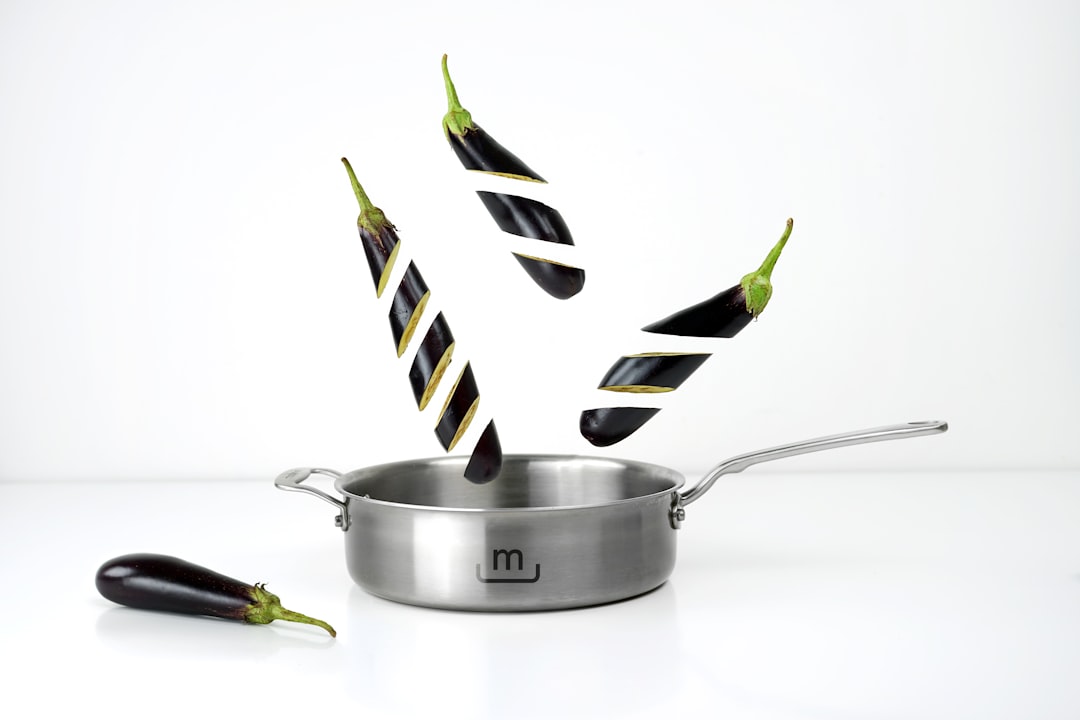The brunoise cut is a precise culinary technique that involves dicing vegetables into small, uniform cubes, typically measuring about 1/8 inch on each side. This method is not merely about aesthetics; it plays a crucial role in the cooking process. The small size of the pieces allows for even cooking and enhances the overall presentation of a dish.
The term “brunoise” originates from the French word “brunois,” which means “brown,” and is often associated with the color of the vegetables used in this cut, particularly when they are sautéed or cooked. To achieve a brunoise cut, one must first julienne the vegetable into thin strips and then turn those strips into small cubes. This technique requires a steady hand and a sharp knife, as precision is key to achieving the desired size and shape.
The brunoise cut is commonly used for ingredients such as onions, carrots, and bell peppers, and it serves as a foundational element in many classic French dishes. The uniformity of the cut not only enhances the visual appeal but also ensures that each piece cooks at the same rate, contributing to a harmonious flavor profile in the final dish.
Key Takeaways
- A Brunoise cut is a precise knife cut that results in small, uniform cubes of vegetables or fruits.
- Uniform ingredients in cooking ensure even cooking and consistent flavor throughout the dish.
- The Brunoise cut has a long history, dating back to French culinary traditions.
- Achieving the perfect Brunoise cut requires sharp knives and proper cutting techniques.
- Common ingredients used for Brunoise cuts include carrots, onions, celery, and bell peppers.
The Importance of Uniform Ingredients in Cooking
Even Cooking
When ingredients are cut into similar sizes, they will cook at the same rate, preventing some pieces from becoming overcooked while others remain undercooked. This is particularly important in dishes that require precise timing, such as stir-fries or sautés, where the texture and flavor of each ingredient can significantly impact the overall dish.
Aesthetic Appeal
Moreover, uniform cuts contribute to the aesthetic appeal of a dish. In culinary arts, presentation is almost as important as taste. A dish that features evenly cut ingredients is visually pleasing and demonstrates a chef’s skill and attention to detail. This is especially true in fine dining, where the visual aspect can elevate the dining experience.
Enhanced Flavor Distribution
Additionally, uniformity can enhance flavor distribution; when ingredients are cut to similar sizes, they can better absorb seasonings and marinades, leading to a more balanced taste throughout the dish.
The History of the Brunoise Cut

The brunoise cut has its roots deeply embedded in French culinary tradition, which has long emphasized precision and technique in cooking. While the exact origins of the brunoise cut are difficult to pinpoint, it is widely believed to have been popularized during the 19th century alongside the rise of classical French cuisine. The term itself is thought to have been coined by chef Marie-Antoine Carême, who was known for his elaborate presentations and meticulous attention to detail.
As French cuisine evolved, so did the techniques associated with it. The brunoise cut became a staple in professional kitchens, particularly in haute cuisine, where presentation and flavor were paramount. Chefs began to recognize that this small dice not only enhanced the visual appeal of dishes but also allowed for more complex flavor combinations.
Over time, the brunoise cut spread beyond French borders, influencing culinary practices worldwide and becoming a fundamental technique taught in culinary schools.
Tools and Techniques for Achieving the Perfect Brunoise Cut
| Tool/Technique | Description |
|---|---|
| Chef’s Knife | A sharp, sturdy knife with a broad blade used for precision cutting. |
| Cutting Board | A flat, stable surface for cutting and chopping ingredients. |
| Vegetable Peeler | Used to remove the skin from vegetables before cutting into brunoise. |
| Knife Skills | Technique for cutting vegetables into small, uniform cubes with precision. |
| Practice | Repetition and practice to improve speed and accuracy in achieving the perfect brunoise cut. |
To achieve a perfect brunoise cut, having the right tools is essential. A sharp chef’s knife is paramount; a dull knife can lead to uneven cuts and increase the risk of accidents. Additionally, a cutting board with a non-slip surface can provide stability while cutting.
Some chefs also prefer using a mandoline slicer for initial cuts, although this tool requires careful handling due to its sharp blades. The technique begins with selecting fresh vegetables that are firm and free from blemishes. After washing and peeling (if necessary), the vegetable should be trimmed into manageable lengths.
For instance, when working with carrots, one might first cut them into sections about 2-3 inches long before proceeding to julienne them into thin strips. Once julienned, these strips can be gathered together and diced into small cubes. It’s crucial to maintain consistent pressure while cutting to ensure uniformity in size.
Practicing this technique will not only improve speed but also enhance precision over time.
Common Ingredients Used for Brunoise Cuts
While many vegetables can be prepared using the brunoise technique, some are more commonly associated with this cut due to their flavor profiles and textures. Onions are perhaps the most frequently used ingredient; their sweetness intensifies when finely diced and sautéed, making them an excellent base for soups, sauces, and various dishes. Carrots also lend themselves well to this technique; their natural sweetness and vibrant color add both flavor and visual appeal.
Bell peppers are another popular choice for brunoise cuts. Their crisp texture and bright colors can elevate any dish, whether used in salads or as part of a mirepoix—a mixture of diced vegetables used as a flavor base in cooking. Other ingredients that can be effectively brunoised include celery, zucchini, and even fruits like apples or pears for use in salads or desserts.
Each ingredient brings its unique flavor profile to the table, allowing chefs to create diverse dishes that showcase their culinary creativity.
How to Incorporate Brunoise Cuts into Your Cooking

Incorporating brunoise cuts into your cooking can elevate both flavor and presentation. One of the most common applications is in soups and sauces where finely diced vegetables can meld seamlessly into the base, enhancing both texture and taste without overwhelming other ingredients. For example, a classic French onion soup benefits from brunoised onions that caramelize beautifully, adding depth to the broth.
Brunoise cuts can also be used as garnishes or toppings for various dishes. A sprinkle of brunoised herbs or vegetables can add color and freshness to a plate, making it visually appealing while also contributing additional layers of flavor. For instance, a dish of seared scallops might be topped with a vibrant mix of brunoised bell peppers and herbs for an added burst of color and taste.
Furthermore, incorporating brunoised ingredients into salads can provide an interesting texture contrast while ensuring that every bite is packed with flavor.
The Culinary Benefits of Using Brunoise Cuts
The culinary benefits of using brunoise cuts extend beyond mere aesthetics; they significantly enhance both flavor integration and cooking efficiency. When ingredients are diced into small cubes, they have a larger surface area relative to their volume compared to larger cuts. This increased surface area allows for better absorption of flavors from marinades or seasonings, resulting in a more harmonious taste throughout the dish.
Additionally, brunoised ingredients cook faster than larger pieces due to their size. This can be particularly advantageous in fast-paced cooking environments where time is of the essence. For instance, when preparing a stir-fry or sautéing vegetables for a quick pasta dish, using brunoised vegetables ensures that everything cooks evenly and quickly without compromising texture or flavor.
This efficiency not only saves time but also allows chefs to focus on other elements of their dishes without worrying about unevenly cooked ingredients.
Tips for Mastering the Brunoise Cut
Mastering the brunoise cut requires practice and patience, but several tips can help streamline the process. First and foremost, invest time in honing your knife skills; a sharp knife is essential for achieving clean cuts without crushing or bruising the vegetables. Regularly practicing your knife techniques will build muscle memory and improve your speed over time.
Another helpful tip is to work with chilled vegetables when possible; cold produce tends to hold its shape better during cutting than room-temperature items. Additionally, take your time when julienning before moving on to dicing; rushing through these steps can lead to uneven pieces that defeat the purpose of achieving a perfect brunoise cut. Finally, consider using a ruler or measuring tool as a guide when starting out; this can help ensure consistency until you feel confident enough to rely on your eye alone.
How to Store and Preserve Brunoise Cuts
Proper storage of brunoised ingredients is crucial for maintaining their freshness and preventing spoilage. If you plan to use them within a day or two, store them in an airtight container in the refrigerator; this will help retain moisture while preventing exposure to air that could lead to oxidation or wilting. For longer storage periods, consider blanching the brunoised vegetables briefly before freezing them.
Blanching involves briefly boiling the vegetables followed by plunging them into ice water; this process helps preserve color, texture, and nutrients while also killing off enzymes that could lead to spoilage during freezing. Once blanched and cooled, drain thoroughly before placing them in freezer-safe bags or containers labeled with dates for easy identification later on.
Variations and Adaptations of the Brunoise Cut
While traditional brunoise cuts are typically associated with vegetables like onions and carrots, there are numerous variations that chefs can explore based on their culinary creativity or specific dish requirements. For instance, some chefs may opt for larger dice known as “mirepoix” (1/4 inch) when preparing stocks or soups where slightly larger pieces are desired for flavor extraction. Additionally, fruits can be adapted into brunoise cuts for use in desserts or salads; finely diced apples or pears can add sweetness and texture contrast when incorporated into savory dishes like salads or grain bowls.
Chefs may also experiment with different shapes beyond cubes—such as triangles or diamonds—while still adhering to similar size guidelines; this adds an artistic flair without straying too far from traditional techniques.
Recipes that Showcase the Beauty of Brunoise Cuts
Several recipes highlight the beauty and utility of brunoise cuts in culinary applications. One classic example is ratatouille—a traditional Provençal dish featuring layers of finely diced vegetables such as eggplant, zucchini, bell peppers, and tomatoes simmered together until tender yet still vibrant in color. The use of brunoised vegetables not only enhances presentation but also allows each ingredient’s flavors to meld beautifully during cooking.
Another recipe that showcases brunoise cuts is a vegetable risotto where finely diced onions, carrots, and celery form the base before adding Arborio rice and broth gradually until creamy perfection is achieved. The small dice ensures even distribution throughout each serving while providing delightful bursts of flavor with every bite. In conclusion, mastering the art of brunoise cutting opens up new avenues for creativity in cooking while enhancing both flavor integration and presentation across various dishes—from soups to salads—allowing chefs at all levels to elevate their culinary creations significantly.



